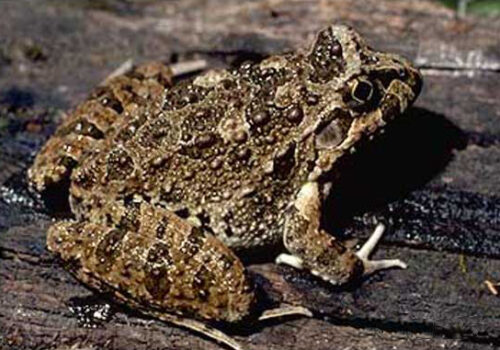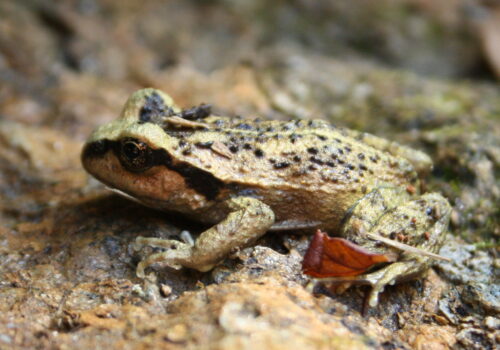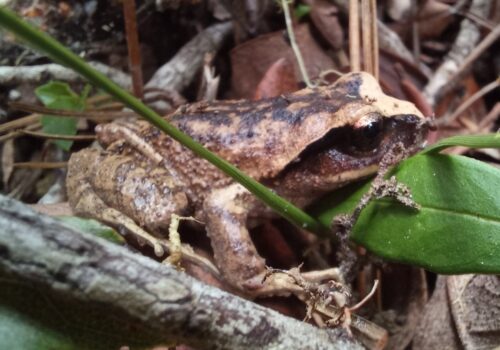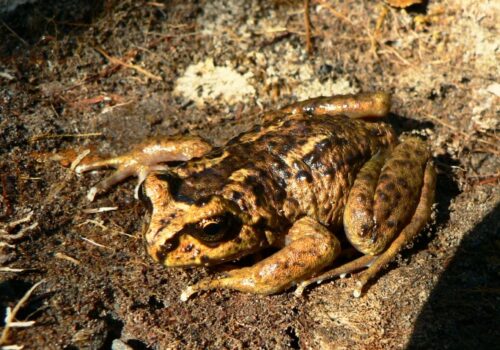- Unveiling Alsodes kaweshkari: The Elusive Sentinel of Patagonia’s Hidden Streams
- Taxonomy and Classification: Finding its Place in Nature’s Great Catalogue
- Natural Habitat: An Amphibian at the Edge of the World
- Physical Characteristics: A Master of Camouflage and Survival
- Behavior and Life Cycle: Tales of Survival in a Harsh Landscape
- Ecological Role: The Amphibious Guardian of Patagonia’s Streams
- Threats and Conservation Status: Challenges in a Changing World
- Cultural and Scientific Significance: Bridging Indigenous Wisdom and Modern Science
- Conclusion: Calling You Into Action
Unveiling Alsodes kaweshkari: The Elusive Sentinel of Patagonia’s Hidden Streams#
In the remote and wild landscapes of Chile’s southern reaches, hidden among crystal-clear streams and dark, verdant mosses, lives a remarkable amphibian known as Alsodes kaweshkari. To many, Patagonia conjures images of jagged peaks and glaciers, yet in these cool, damp forests lies a quieter, equally captivating world—one ruled by delicate creatures thriving where ice meets the rainforest.
Alsodes kaweshkari, named in honor of the Kawésqar indigenous people of the Patagonian fjords, emerges as a guardian of these fragile ecosystems. This frog, belonging to the family Alsodidae, is not merely a curiosity of science but a living tale of evolutionary adaptation. Its story, intertwined deeply with the landscapes and ecosystems of southern Chile, offers vital clues to the health and future of Patagonia’s biodiversity.
So, what makes this understated amphibian remarkable, worthy of our attention and conservation efforts? Let’s take a journey into the secluded world of Alsodes kaweshkari, unraveling the narrative of its unique existence.
Taxonomy and Classification: Finding its Place in Nature’s Great Catalogue#
Alsodes kaweshkari belongs to the family Alsodidae, a group known for its resilience in harsh climates, often thriving where few other amphibians venture. Within this family, the genus Alsodes includes frogs specifically adapted to colder, wetter ecosystems typically found in southern South America. Alsodes kaweshkari itself was formally described relatively recently, emphasizing an ongoing journey of scientific discovery in this remote and challenging environment.
Its relatives include other species of Alsodes frogs, each specializing in similar chilly and saturated habitats. However, subtle distinctions in appearance, behavior, and habitat preference help biologists classify this special amphibian clearly and distinctly. Within its taxonomic lineage, Alsodes kaweshkari underscores the remarkable biodiversity hidden in Patagonia’s secret coves and pristine streams.
Natural Habitat: An Amphibian at the Edge of the World#
Journeying southward through Chile, one encounters breathtaking fjords, ancient temperate rainforests, and crystalline glacial streams—all nurturing grounds for Alsodes kaweshkari. Specifically, this frog has been recorded within the cool, damp confines of southern Chile’s remote Magellanic forests and alpine wetlands. These unique ecosystems blend lush vegetation, rocky shores, crystal-clear freshwater, and highly fluctuating temperatures.
The typical habitat favored by Alsodes kaweshkari is close to small, slow-running mountain streams lined with dense mosses, ferns, and lichens. Here, the delicate balance between moisture, temperature, and vegetation cover provides an ideal refuge. Moreover, the continuous availability of hideouts beneath rocks, logs, and deep moss carpets allows these frogs to evade predators while maintaining crucial humidity levels necessary for their sensitive skin.
It’s not merely about space, but the quality of the habitat; the pristine nature of Patagonian streams and their limited accessibility to humans mean pollution remains minimal. In these untouched conditions, the frogs thrive as indicators of ecological health, alerting biologists to changes in water purity or ambient climate conditions long before human senses detect them.
Physical Characteristics: A Master of Camouflage and Survival#
At a glance, Alsodes kaweshkari appears perfectly crafted by nature itself to blend seamlessly into Patagonia’s lush underbrush. Adult frogs typically measure around 4 to 6 centimeters, their compact, sturdy limbs hinting at their terrestrial and aquatic prowess. Their coloration is subtly beautiful—a muted palette of greens, grays, and browns interwoven into intricate patterns mimicking wet foliage, mossy stones, and fresh leaf litter.
The semi-permeable, moist skin serves essential functions beyond mere camouflage. It plays a key role in respiration, absorbing environmental moisture, and maintaining hydration in the cool, humid climates of their natural habitats. The coloration and texture of their skin afford them remarkable concealment from predators, including birds, snakes, and small mammals that patrol these forest environments.
Interestingly, subtle adaptations appear tailored to life in fluctuating, harsh climates. These frogs have robust, muscular legs designed not only for hopping and hunting but also for digging shallow burrows or navigating slippery, damp terrain. Exceptionally suited to the cold, their metabolic processes can withstand temperature fluctuations that might prove fatal to other amphibians, allowing survival through Patagonia’s sometimes inhospitable weather.
Behavior and Life Cycle: Tales of Survival in a Harsh Landscape#
As daylight fades over Patagonia, silencing birds and quieting the murmurs of wind through ancient trees, Alsodes kaweshkari comes alive. Nocturnal by nature, these frogs venture cautiously from hiding places under rocks and fallen logs, embarking on nightly hunts. Their diet predominantly consists of invertebrates—small beetles, insects, spiders, and larvae found in abundance beneath damp leaf litter or along stream banks.
Breeding occurs during the wettest months, usually from late spring to early summer. Male frogs gather near stream margins, their collective calls a soft, discrete chorus, audible only to keen observers who brave the chill. This gentle vocalization, almost like a murmured symphony, serves to attract females and assert territorial dominance.
Upon successful mating, females deposit gelatinous egg masses carefully concealed under submerged rocks or leaf debris in shallow stream pools. Here, eggs develop under the gentle water flow, sheltered from potential predators like fish or predatory insects. Tadpoles emerge several days later, immediately adapting to life submerged, feeding on microscopic algae and organic debris.
Remarkably, the tadpoles possess adaptive behaviors that maximize survival rates; sensing danger approaching, they can retreat deep into submerged vegetation or bury themselves briefly beneath sediment. This strategy ensures many survive the challenging stages of development, eventually metamorphosing into miniature versions of their parents—fully equipped to survive Patagonia’s rigorous conditions.
Ecological Role: The Amphibious Guardian of Patagonia’s Streams#
The humble Alsodes kaweshkari plays a surprisingly pivotal role in maintaining ecological balance within its distinctive habitats. As a predator of numerous insects and invertebrates, it helps regulate prey populations, consequently managing insect-generated ecosystem pressures. Conversely, as prey themselves, these frogs sustain populations of birds, snakes, and small mammals, forming a key link in the intricate food webs of Magellanic forests.
Additionally, amphibians like Alsodes kaweshkari are particularly sensitive bioindicators. They rapidly respond to environmental changes—from slight alterations in water quality to subtle shifts in climate. Scientists tracking populations of these frogs gain vital insight into broader environmental health, making this humble species an indispensable indicator of ecosystem integrity.
Threats and Conservation Status: Challenges in a Changing World#
Unfortunately, even secluded Patagonia is not immune from modern ecological threats. Although detailed population studies remain scarce due to their remote habitat, early indicators suggest that Alsodes kaweshkari populations face growing pressures. Habitat degradation resulting from deforestation, infrastructure projects, and climate change-induced variations in precipitation threaten the delicate ecological balance this frog depends upon.
Currently classified as “Data Deficient” by the IUCN, the uncertain future of Alsodes kaweshkari highlights the pressing need for targeted areas of research, assessment, and conservation initiatives. Small-scale conservation programs focusing on habitat preservation, education, and scientific outreach provide hope for safeguarding Patagonia’s hidden amphibian treasure.
Cultural and Scientific Significance: Bridging Indigenous Wisdom and Modern Science#
The embrace of the Kawésqar people’s name into this species highlights not only scientific recognition but also cultural acknowledgment of indigenous peoples’ connection to Patagonian ecosystems. The traditional wisdom of Patagonia’s indigenous peoples continually fosters deep appreciation and respect for the region’s wildlife, including its smallest and most understated inhabitants.
Conclusion: Calling You Into Action#
The quiet saga of Alsodes kaweshkari represents far more than an amphibian’s struggle for existence; it draws our attention to the intricate connections between climate, culture, conservation, and biodiversity. By understanding and valuing this hidden gem of Chile’s southern wilderness, we empower ourselves to protect and preserve Patagonia’s spectacular natural heritage for generations to come.
Let us commit to supporting conservation efforts, expanding research, and spreading appreciation for remarkable creatures like Alsodes kaweshkari. Together, we can ensure they continue thriving quietly, beautifully, hidden among Patagonia’s cool, misty realms, guarding their secret streams at the edge of the world.









